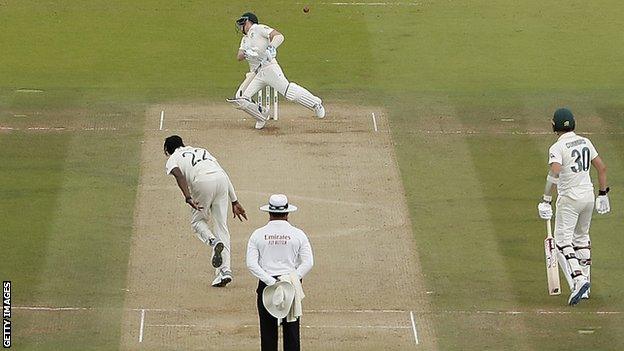Ashes 2019: 'Exciting and terrifying - Jofra Archer shows what pace can do'
- Published
Fast bowlers star as second Test evenly poised - day four highlights
The fourth day of the second Ashes Test was a perfect example of what genuine fast bowling can do.
Not only how it alters the contest going on in that moment in the middle, but how it engages the crowd and, possibly, has a lasting effect on the battles to come.
We have not seen an England bowler generate the sort of pace that Jofra Archer managed on Saturday at Lord's for some time.
It was exciting and it was terrifying, especially when you saw a batsman of the skill and calibre of Steve Smith hit on the neck like he was. It was a horrible blow, one that left him face down on the turf.
In an instant, the crowd went from thrilled to worried. Maybe they had the tragedy of Phillip Hughes in mind.
Hughes died in 2014, aged 25, two days after being struck on the top of the neck by a ball during a domestic match in Sydney.
Thankfully, Smith passed the medical tests and courageously emerged to bat once more. Still, it was a brutal reminder of what cricket can do and how brave international batsmen have to be when they are facing up to bowlers like Archer.
Intimidation is part of the game. When the ball is whizzing around noses at speeds in excess of 90mph, it separates the men from the boys.
Can a batsman get out there, get in line and play it?
It makes for compelling viewing, but at the same time we are hoping and praying that a batsman doesn't get hurt.
Yes, they are better protected than in days gone by, when they would face up to a battery of West Indian quicks with nothing but a cap on their heads.
But that still doesn't change the fact that the ball is a missile, hurled at the batsman with the very real prospect of him suffering an injury.
Smith retires hurt after being struck on the neck by Archer
And, not only is the batsman trying to avoid being hit, he is also trying to keep his wicket intact. The fastest bowlers can make a player do strange things, play shots they wouldn't usually play. One tiny incorrect movement, one slight miscalculation, and your innings is over.
All of this, the threat to both body and wicket, means the game is taken up a notch when the fastest bowlers are in action.
One thinks back to a contest like Allan Donald and Mike Atherton, when the South Africa quick peppered the England opener in 1998.
Back then, Donald's face was contorted and twisted with rage. He had steam coming out of his ears.
Archer isn't like that. He is very undemonstrative, like my old colleague Andy Roberts, who never said a word or even looked at the batsman. He just ran in and bowled. In some ways, that can add to the terror.
For Archer, this was a day when we really learned what the hype was all about. Yes, he had a very good World Cup, but England were a fine one-day side before he arrived.
It is the Test side that has really been crying out for his pace, particularly abroad, and at Lord's he showed exactly what he can do.
The Sussex man has a very smooth, rhythmical action. He makes fast bowling look so easy, and yet he can propel the ball at such high speed.

Smith had already been struck on the arm by Archer when he was hit by this brutal short ball from the England fast bowler
In the spell to Smith, which was the sort of thing we had been anticipating since we knew Archer would be involved in this series, he bowled eight consecutive overs, showing excellent stamina.
Before today, he may have just been seen as a fresh 24-year-old with potential, but who is unproven on the world stage.
Now, word will get around. His reputation will spread. Batsmen will not relish facing him, which sometimes can be half the battle won for the bowler.
There's no question that his inclusion has upped the ante of the entire series, which will now probably see hostile pace bowling as a recurring theme.
It was Australia's Pat Cummins who dished out some treatment to Archer when he was batting, so perhaps it was no surprise that Archer himself then cranked it up. When Cummins came to bowl again on Saturday evening, he too got up to high speed to remove Jason Roy and Joe Root in successive balls.
This is what Ashes cricket is all about. You want the teams going full throttle at each other. That doesn't mean the cricket has to be bad tempered - you don't want verbal insults or threats flying around - but you do want to see both teams fired up.
Saturday's action has left the game well poised. England lead by 104 runs with six second-innings wickets in hand.
If that sounds like a position from which it is difficult to force a result on the final day, remember that these are two fragile batting units, with two excellent bowling attacks that could exploit a pitch showing some uneven bounce.
England are, marginally, under more pressure. They must look to bat beyond lunch, then attempt to bowl Australia out.
Jonathan Agnew was speaking to BBC Sport's Stephan Shemilt.
